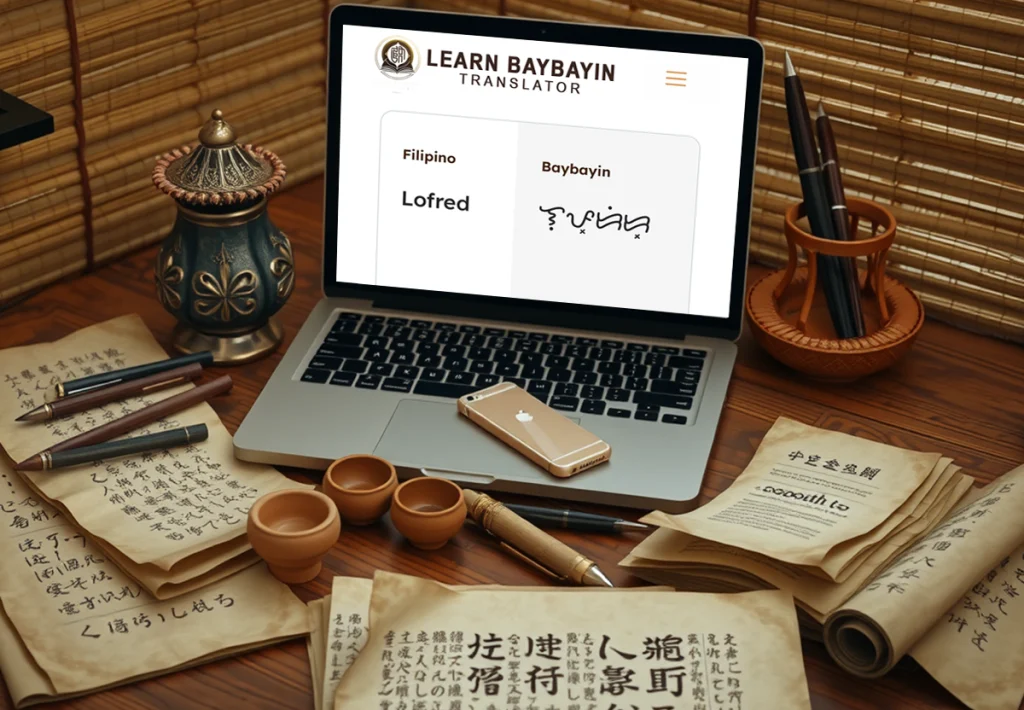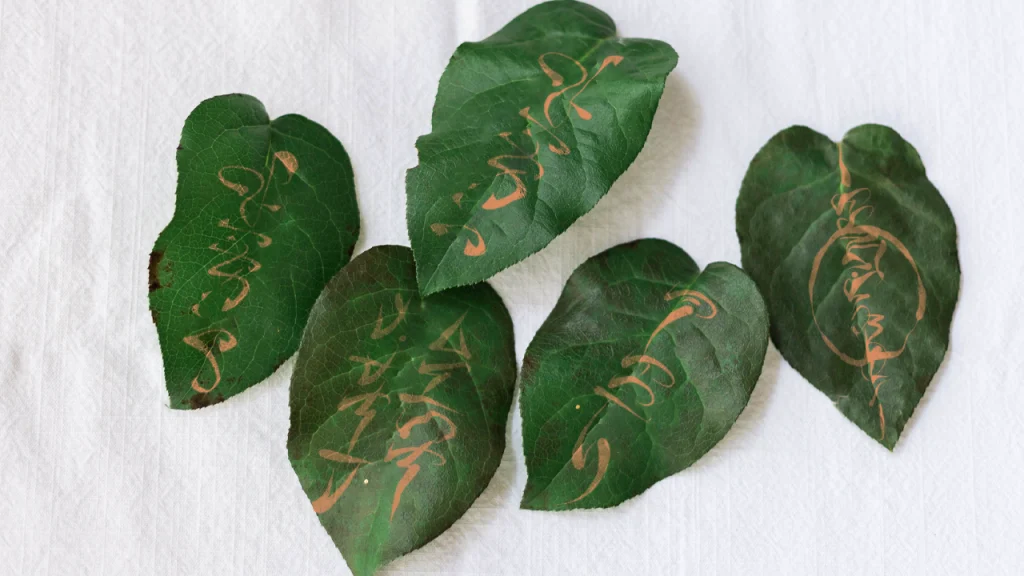Baybayin Translator: Bring Ancient Filipino Script to Life
A Baybayin Translator is an online or digital tool that lets you convert modern Filipino words and even English names or phrases into Baybayin, the ancient pre-colonial script of the Philippines. Baybayin was widely used before Spanish colonization, but over time it nearly faded away. Today, thanks to cultural revival movements, artists, and digital tools, Baybayin is making a strong comeback. Using a Baybayin Translator is not only a fun way to see your name or favorite word in this beautiful script, but also a meaningful way to connect with Filipino heritage and identity.



Baybayin Vs Alibata
Many Filipinos mistakenly refer to Baybayin as “Alibata,” a term coined in the early 20th century by Paul Versoza, a teacher who believed the script should resemble the Arabic alphabet (beginning with alif, ba, ta). However, the correct and historically accurate term is Baybayin, which is supported by linguistic and historical evidence.
Baybayin vs Alibata: Comparison Table
| Feature | Alibata | |
|---|---|---|
| Origin of Name | From Tagalog word “baybay” (to spell) | Coined by Paul Versoza in 20th century |
| Linguistic Accuracy | Historically accurate and documented | Inaccurate and not based on evidence |
| Script Influence | Derived from Brahmic scripts (e.g., Kawi) | Falsely believed to have Arabic origins |
| Number of Characters | 17 characters (14 consonants + 3 vowels) | Often misrepresented or misunderstood |
| Current Usage | Revived in schools, art, signage, and culture | Rarely used, discouraged in academic settings |
| First Use | Pre-colonial era (before Spanish arrival) | Early 1900s as a modern term |
Is Baybayin Still Used Today?
Yes, but not widely. Baybayin was replaced by the Latin alphabet during the Spanish era, but there’s a growing effort to bring it back. It’s now taught in some schools, used in public signage, and popular among artists and designers. Tools like the Baybayin Translator are part of this cultural revival.
Fun Fact: Not All Letters Exist in Baybayin
Baybayin doesn’t have characters for every modern Filipino or English letter. For example, the letters “C,” “F,” “J,” “Q,” “V,” “X,” and “Z” didn’t exist in the original script. Translators often adapt these using similar sounds.
Why Use Our Baybayin Alphabet Translator?
- Instant Conversion: Simply enter your text in Filipino or English, and our translator will instantly convert it into ancient script characters.
- User-Friendly Interface: No technical knowledge required. Just type and translate – it’s that easy!
- Accurate Translations: Our tool ensures that each character from the modern alphabet is correctly mapped to its historical equivalent.
- Mobile and Desktop Compatibility: Whether on your smartphone or computer, our translator works seamlessly across all devices.
- Perfect for Learning: If you’re studying this indigenous writing system, this tool provides an ideal way to practice and reinforce your knowledge of the Baybayin alphabet.
Baybayin Chart – Learn the Ancient Filipino Script
A Baybayin chart serves as a visual guide to the ancient Filipino writing system that was in use before Spanish colonization. This syllabic script, where each symbol represents a syllable, was historically common in Luzon and other regions of the Philippines. Today, it is experiencing a cultural revival through tattoos, art, and educational initiatives.
Understanding the Baybayin Script
Baybayin consists of 17 characters—14 consonants and 3 vowels—each pronounced with an inherent “A” sound. The sound changes with the use of diacritics (kudlit) placed above or below the symbol to represent “E/I” or “O/U.”
Basic Chart:
| Roman Letter | Symbol | With “E/I” Sound | With “O/U” Sound |
|---|---|---|---|
| A | ᜀ | — | — |
| E / I | ᜁ | — | — |
| O / U | ᜂ | — | — |
| B | ᜊ | ᜊᜒ | ᜊᜓ |
| K | ᜃ | ᜃᜒ | ᜃᜓ |
| D | ᜇ | ᜇᜒ | ᜇᜓ |
| G | ᜄ | ᜄᜒ | ᜄᜓ |
| H | ᜑ | ᜑᜒ | ᜑᜓ |
| L | ᜎ | ᜎᜒ | ᜎᜓ |
| M | ᜋ | ᜋᜒ | ᜋᜓ |
| N | ᜈ | ᜈᜒ | ᜈᜓ |
| NG | ᜅ | ᜅᜒ | ᜅᜓ |
| P | ᜉ | ᜉᜒ | ᜉᜓ |
| R / L | ᜎ | ᜎᜒ | ᜎᜓ |
| S | ᜐ | ᜐᜒ | ᜐᜓ |
| T | ᜆ | ᜆᜒ | ᜆᜓ |
| W | ᜏ (used for final syllables or blends) | ||
| Y | ᜌ | ᜌᜒ | ᜌᜓ |
Why Use a Baybayin Translator?
Here are a few reasons people are turning to Translator tools:
- ✅ Learn and Practice the Ancient Script Easily
- No need to memorize the alphabet right away. Translators help you recognize characters and improve over time.
- ✅ Reconnect with Filipino Heritage
- Using this indigenous writing system is more than a trend—it’s a way to honor and preserve native culture.
- ✅ Create Personalized Gifts or Tattoos
- Many people choose this script for custom jewelry, tattoos, t-shirts, and art.
- ✅ Academic and School Projects
- Teachers and students use tools based on this ancient system for history, language, and cultural studies.
- Whether you’re learning or creating, Baybayin brings Filipino tradition to life in meaningful ways.
Why Choose a Baybayin Tattoo Design?
A Baybayin tattoo is more than just ink—it’s a statement of heritage, pride, and meaning. Here’s why it’s trending:
✔️ Cultural Pride
Celebrate your Filipino ancestry with a script that predates colonial influence.
✔️ Unique Aesthetic
Baybayin characters are elegant and organic—perfect for minimalist, tribal, or modern tattoo styles.
✔️ Hidden Meaning
Unless someone knows Baybayin, your tattoo has a mysterious, personal feel—ideal for meaningful names or values.
✔️ Personal Empowerment
Many choose words like “Lakas” (strength), “Pag-ibig” (love), or “Kalayaan” (freedom) to reflect their personal journey.



Popular Baybayin Tattoo Ideas
Here are some of the most popular and meaningful Baybayin tattoo designs:
| Word | Script | Meaning |
|---|---|---|
| Mahal | ᜋᜑᜎ | Love or Beloved |
| Laya | ᜎᜌ | Freedom |
| Katatagan | ᜃᜆᜆᜄᜈ᜔ | Resilience/Strength |
| Pamilya | ᜉᜋᜎᜌ | Family |
| Pananampalataya | ᜉᜈᜈᜋᜉᜎᜆᜌ | Faith |
Tips for Writing in Baybayin Manually
Want to go beyond digital tools? Here are quick tips for writing Baybayin by hand:
- Use kudlít marks for vowels (above for “e/i”, below for “o/u”)
- Each character represents a syllable, not a single letter
- Use a virama (x-shaped mark) to cancel the default vowel
Can I Use Baybayin Translator for English Words?
Yes! Although Baybayin is best suited for Tagalog, you can still use it to phonetically spell out English words. The translator adapts the closest syllables to match the original word’s pronunciation.
Best Practices for Using a Baybayin Translator Tool
To get the most out of the tool:
- Stick to phonetic spelling when inputting names
- Use shorter words or phrases for better visual clarity
- Double-check translations with a Baybayin chart if accuracy is critical (e.g., tattoos)
Mobile-Friendly: Use Baybayin Translator on Any Device
Many translation tools for the ancient Baybayin script are mobile-friendly, making it easy to learn and convert text anytime, anywhere—even on the go.
The Difference Between Baybayin and Other Filipino Scripts
While Baybayin is the most well-known, it’s not the only ancient script in the Philippines. Others include Hanunóo, Buhid, and Tagbanwa. These scripts come from different regions and are still used by indigenous groups. however, was the most widespread in the Tagalog-speaking areas and is the most recognized script being revived today.
How Baybayin Is Being Taught in Modern Education
There is a growing movement to include Baybayin in the Philippine education system. Some schools have started offering modules or electives that explore the script’s history and usage. Additionally, cultural organizations are conducting workshops and seminars to help more Filipinos rediscover their writing heritage.
Baybayin Letters and Syllables
Basic Consonant-Vowel Syllables
Baybayin includes 14 basic consonants, each with an inherent vowel sound. Diacritical marks (called kudlít) are added to modify the vowel sound.
| Latin Sound | Base Symbol | + “for “i/e” | + “for “o/u” |
|---|---|---|---|
| A | ᜀ | – | – |
| BA | ᜊ | ᜊᜒ | ᜊᜓ |
| KA | ᜃ | ᜃᜒ | ᜃᜓ |
| DA/RA | ᜇ | ᜇᜒ | ᜇᜓ |
| GA | ᜄ | ᜄᜒ | ᜄᜓ |
| HA | ᜑ | ᜑᜒ | ᜑᜓ |
| LA | ᜎ | ᜎᜒ | ᜎᜓ |
| MA | ᜋ | ᜋᜒ | ᜋᜓ |
| NA | ᜈ | ᜈᜒ | ᜈᜓ |
| NGA | ᜅ | ᜅᜒ | ᜅᜓ |
| PA | ᜉ | ᜉᜒ | ᜉᜓ |
| SA | ᜐ | ᜐᜒ | ᜐᜓ |
| TA | ᜆ | ᜆᜒ | ᜆᜓ |
| YA | ᜌ | ᜌᜒ | ᜌᜓ |
Vowel Marks (Kudlít)
Baybayin characters include three vowel variations:
- No mark = a
- Dot or mark above = i / e
- Dot or mark below = o / u
Modern Revival of Baybayin
In recent years, there has been a Baybayin revival movement in the Philippines. Artists, educators, and cultural advocates have embraced the script as a powerful emblem of Filipino identity.
Modern Uses:
- Baybayin tattoos and artwork
- Logos of institutions (e.g., the National Museum and Cultural Center of the Philippines)
- Baybayin street signs and public installations
- Proposed legislation such as the “National Writing System Act” (House Bill 1022), which aims to promote Baybayin in government communication and education
Conclusion of Baybayin Translator
The use of a Baybayin translator plays a vital role in preserving and revitalizing one of the Philippines’ most significant cultural heritages. By allowing modern users to convert words, names, and phrases into this ancient script, translators tool help bridge the gap between the past and present. These tools not only promote awareness of pre-colonial Filipino identity, but also foster appreciation for the country’s indigenous writing systems.
Easy Steps to Install Baybayin Translator on Your Mobile Phone
To install the translator app on your mobile phone, simply visit the App Store (iOS) or Google Play Store (Android). Search for “Baybayin Translator” and click “Install” or “Get” to download. Once installed, you can start converting Filipino text into ancient script characters right from your phone.
Conclusion
The Filipino to Baybayin translator is a powerful tool that bridges the gap between modern technology and Filipino heritage. It allows users to reconnect with their cultural roots and learn about the rich history of the Philippines. With various apps available on both Android and iOS, these translators offer an accessible way for Filipinos and anyone interested in Filipino culture to explore and preserve the ancient Baybayin script.
FAQs
Q: What languages can be translated in Baybayin letters?
Baybayin was mainly used for Tagalog and other Philippine languages such as Ilocano, Kapampangan, and Bisaya. While not originally designed for English or Spanish, modern adaptations allow almost any word to be written in Baybayin by breaking it into syllables.
Q: What’s the difference between Alibata and Baybayin?
Alibata is a misnomer introduced in the 20th century. The correct term is Baybayin, which is the authentic ancient Filipino writing system.
Q: Can Baybayin represent every sound in the modern Filipino language?
Not exactly. Baybayin has only basic syllables, so some modern sounds are missing. Today, extended versions add extra marks to cover more sounds.
Q: Can all modern words be translated into Baybayin?
Yes, but with limitations. Baybayin doesn’t have letters for every modern sound (like “F,” “V,” or “Z”), so some words may need adjustments or alternative spellings.
Q: Can I use Baybayin for tattoos or art?
Absolutely. Many people use Baybayin for meaningful tattoos, custom designs, and cultural art pieces.
Q: How is Baybayin different from other Philippine scripts?
Baybayin is one of several indigenous scripts. Others include Kulitan (Kapampangan) and Hanunóo (Mangyan). Each has unique characters, but Baybayin is the most widely recognized.
Q: Why are kudlits important in Baybayin?
Kudlits are small marks placed above or below characters to change the vowel sound (from “a” to “e/i” or “o/u”). Without kudlits, words may be misread.
Q: Can I use Baybayin for names?
Yes! Baybayin is often used to write Filipino names phonetically. Just make sure the name is spelled according to how it sounds.
Q: How can I learn to write Baybayin manually?
You can start by practicing the basic 17 Baybayin characters and learning kudlits (marks for vowels). Many guides, books, and online tutorials provide step-by-step practice.
Q: Are there apps or digital tools to learn Baybayin?
Yes. Several Baybayin keyboard apps, translators, and online fonts are available for mobile and desktop, making it easier to learn and use.
Q: Is there a Baybayin Translator I can copy and paste text into?
Yes. Several online Baybayin translators allow you to copy and paste text (English, Tagalog, or other words) and instantly see the Baybayin script version.
